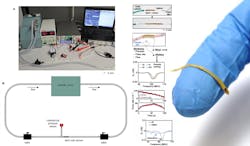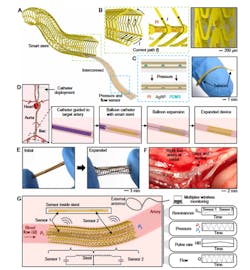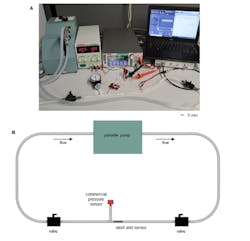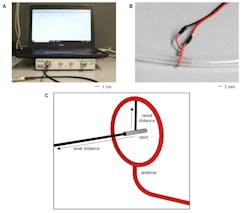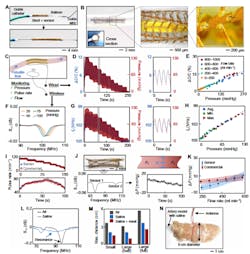Printed Inductive Stent + Sensor Captures, Reports Blood-Flow Data
What you’ll learn:
- How a wireless stent can be used for an implanted sensor and inductive link.
- How the wireless stent was fabricated and used.
- How the stent’s performance was evaluated.
There are multiple options for powering implanted medical sensors and devices, and each has its attributes. Among the choices are one-time battery, rechargeable battery, a body-fluid battery, and transmitted/coupled power. Obviously, the “right” option in a given situation is a function of the power needs and anticipated device lifetime. The standard way to monitor the relevant blood-flow-related factors is with an angiogram, which is complicated, costly, and may require use of dyes.
Now, researchers at the Georgia Institute of Technology (Georgia Tech) have devised a tiny “printed” sensor for continuous monitoring of hemodynamics—blood flow through the vascular system. It will provide insight into conditions such as hypertension and atherosclerosis, which occur in long and twisting vascular systems with arteries of varying diameter and curvature. Their approach is based on a wireless smart-stent platform with integrated soft sensors that uses inductive coupling for real-time monitoring.
The device offers real-time, simultaneous monitoring of pressure, pulse rate, and flow. Their fully printed pressure sensors function as a resonant LC-tank circuit and change dimensions with blood-flow pulsations, thus shifting their resonant frequency—a shift that can be detected wirelessly. The sensors have fast response times and high durability, and they provide sensing even at the small bending radii of the body’s arteries (Fig. 1).
Inductive Stent and Printed Pressure Sensors
The device consists of two integrated parts. They used a laser-machining process to form a multimaterial inductive stent that addresses the challenge of enabling wireless connectivity while maintaining critical stent dimensions and mechanics (note that they tested various stent geometries for suitable inductive performance). The soft pressure sensors are subsequently printed using an aerosol jet and then conformally integrated with the stent. Keep in mind that stents must be fairly narrow to be implantable, with a typical diameter of a millimeter or less.
By using a printed elastomer pattern as the dielectric, they achieved fast response times and pressure sensing even with a bending radius of 0.25 mm. They say that’s a key advantage because flexible pressure sensors often have difficulties sensing during bending or degrade at bending radii as large as tens of millimeters.
Test Procedures and Results
The wireless device is compatible with conventional medical-stenting procedures and had a 5.5-cm readout distance in air and 3.5 cm in blood, which is a 2X to 3X improvement in the wireless distance compared to existing stent-based devices. Baseline resonant frequencies of devices in the artery model ranged from 70 to 110 MHz, depending on stent inductance and sensor capacitance. The device was tested in both a biomimetic silicone artery with pulsatile flow (Fig. 2) as well as via an in vivo study in a rabbit.
The stent used 27 loops with a wire width of 120 mm and a length of 28 mm. Wireless performance was characterized using a loop reader antenna connected to a vector network analyzer (VNA), which recorded the S11 parameter of the expanded stent integrated with a printed capacitive sensor (Figs. 3 and 4).
Test results across multiple physiological parameters showed good correlation with other established techniques (Fig. 5).
“Basically, you can put this sensor system anywhere inside the body,” noted lead researcher Woon-Hong Yeo. “The other thing about this technology platform is, in addition to being an implantable sensor system, it can be used as a wearable system. Think about a smartwatch and how much of its bulk is taken up by circuits or batteries. If you remove all of that, you have a device that is thinner than a typical Band-Aid, an almost invisible health monitor that you can wear anywhere.”
Their readable 13-page paper “Fully implantable wireless batteryless vascular electronics with printed soft sensors for multiplex sensing of hemodynamics” in Science Advances provides extensive background, concept, fabrication, and evaluation details. That formal paper also has an interesting table where they provide a performance comparison of their approach versus other implantable, wireless arterial sensors and systems.
In addition, they posted a comprehensive, 45-page Supplementary Materials file that not only provides even more depth but also shows and models some of the stent geometries they evaluated but decided to not use.
About the Author

Bill Schweber
Contributing Editor
Bill Schweber is an electronics engineer who has written three textbooks on electronic communications systems, as well as hundreds of technical articles, opinion columns, and product features. In past roles, he worked as a technical website manager for multiple topic-specific sites for EE Times, as well as both the Executive Editor and Analog Editor at EDN.
At Analog Devices Inc., Bill was in marketing communications (public relations). As a result, he has been on both sides of the technical PR function, presenting company products, stories, and messages to the media and also as the recipient of these.
Prior to the MarCom role at Analog, Bill was associate editor of their respected technical journal and worked in their product marketing and applications engineering groups. Before those roles, he was at Instron Corp., doing hands-on analog- and power-circuit design and systems integration for materials-testing machine controls.
Bill has an MSEE (Univ. of Mass) and BSEE (Columbia Univ.), is a Registered Professional Engineer, and holds an Advanced Class amateur radio license. He has also planned, written, and presented online courses on a variety of engineering topics, including MOSFET basics, ADC selection, and driving LEDs.
